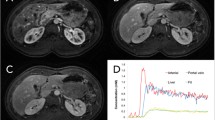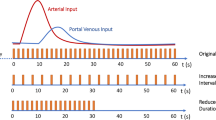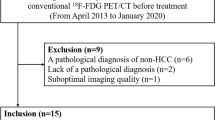Abstract
Purpose
The aim of this study was to compare the maximum-slope (MS) and dual-input one-compartment model (DOCM) methods in hepatic perfusion computed tomography (CT).
Materials and methods
A total of 37 patients with known or suspected liver disease underwent single-location dynamic CT after arterial or venous bolus injection of contrast material. Perfusion CT images were created by the MS (dividing the peak gradient of the time-attenuation curve by the peak vessel CT number) and DOCM—calculating from the equation dC L (t)/dt = k a C a (t − τ a ) + k p C p (t − τ p ) − k v C L (t)—methods. The perfusion parameters hepatic arterial perfusion (HAP), portal venous perfusion (PVP), and hepatic perfusion index (HPI) were determined.
Results
The PVP of the tumor-free hepatic parenchyma determined by the MS method was lower than that obtained by the DOCM method (P < 0.001) with both injections. HAP determined by the MS method was lower than that obtained by the DOCM method with venous injection (P = 0.001), although there was no difference between the methods for HAP with arterial injection (P = 0.154). Most of the perfusion parameters showed linear correlations between the two analytical methods.
Conclusion
Except for HAP with arterial injection, the perfusion parameters obtained with the MS method were lower than those obtained with the DOCM method.
Similar content being viewed by others
References
Bader TR, Herneth AM, Blaicher W, Steininger R, Muhlbacher F, Lechner G, et al. Hepatic perfusion after liver transplantation: noninvasive measurement with dynamic single-section CT. Radiology 1998;209:129–134.
Hashimoto K, Murakami T, Dono K, Hori M, Kim T, Kudo M, et al. Assessment of the severity of liver disease and fibrotic change: the usefulness of hepatic CT perfusion imaging. Oncol Rep 2006;16:677–683.
Leggett DA, Kelley BB, Bunce IH, Miles KA. Colorectal cancer: diagnostic potential of CT measurements of hepatic perfusion and implications for contrast enhancement protocols. Radiology 1997;205:716–720.
Sahani DV, Holalkere NS, Mueller PR, Zhu AX. Advanced hepatocellular carcinoma: CT perfusion of liver and tumor tissue—initial experience. Radiology 2007;243:736–743.
Sahani DV, Kalva SP, Hamberg LM, Hahn PF, Willett CG, Saini S, et al. Assessing tumor perfusion and treatment response in rectal cancer with multisection CT: initial observations. Radiology 2005;234:785–792.
Tsushima Y, Blomley MJ, Yokoyama H, Kusano S, Endo K. Does the presence of distant and local malignancy alter parenchymal perfusion in apparently disease-free areas of the liver? Dig Dis Sci 2001;46:2113–2119.
Tsushima Y, Endo K. Portal perfusion measurement on dynamic CT in patients with liver cirrhosis. AJR Am J Roentgenol 2005;185:813.
Van Beers BE, Leconte I, Materne R, Smith AM, Jamart J, Horsmans Y. Hepatic perfusion parameters in chronic liver disease: dynamic CT measurements correlated with disease severity. AJR Am J Roentgenol 2001;176:667–673.
Taniguchi H, Oguro A, Koyama H, Masuyama M, Takahashi T. Analysis of models for quantification of arterial and portal blood flow in the human liver using PET. J Comput Assist Tomogr 1996;20:135–144.
Peters AM, Gunasekera RD, Henderson BL, Brown J, Lavender JP, De Souza M, et al. Noninvasive measurement of blood flow and extraction fraction. Nucl Med Commun 1987;8:823–837.
Blomley MJ, Coulden R, Dawson P, Kormano M, Donlan P, Bufkin C, et al. Liver perfusion studied with ultrafast CT. J Comput Assist Tomogr 1995;19:424–433.
Hagiwara M, Rusinek H, Lee VS, Losada M, Bannan MA, Krinsky GA, et al. Advanced liver fibrosis: diagnosis with 3D whole-liver perfusion MR imaging: initial experience. Radiology 2008;246:926–934.
Leen E, Goldberg JA, Anderson JR, Robertson J, Moule B, Cooke TG, et al. Hepatic perfusion changes in patients with liver metastases: comparison with those patients with cirrhosis. Gut 1993;34:554–557.
Materne R, Smith AM, Peeters F, Dehoux JP, Keyeux A, Horsmans Y, et al. Assessment of hepatic perfusion parameters with dynamic MRI. Magn Reson Med 2002;47:135–142.
Slimani L, Kudomi N, Oikonen V, Jarvisalo M, Kiss J, Naum A, et al. Quantification of liver perfusion with [15O]H2O-PET and its relationship with glucose metabolism and substrate levels. J Hepatol 2008;48:974–982.
Martin-Comin J, Mora J, Figueras J, Puchal R, Jaurrieta E, Badosa F, et al. Calculation of portal contribution to hepatic blood flow with 99mTc-microcolloids: a noninvasive method to diagnose liver graft rejection. J Nucl Med 1988;29:1776–1780.
Miles KA, Hayball MP, Dixon AK. Functional images of hepatic perfusion obtained with dynamic CT. Radiology 1993;188:405–411.
Miles KA. Measurement of tissue perfusion by dynamic computed tomography. Br J Radiol 1991;64:409–412.
Miles KA, Griffiths MR. Perfusion CT: a worthwhile enhancement? Br J Radiol 2003;76:220–231.
Materne R, Van Beers BE, Smith AM, Leconte I, Jamart J, Dehoux JP, et al. Non-invasive quantification of liver perfusion with dynamic computed tomography and a dual-input one-compartmental model. Clin Sci (Lond) 2000;99:517–525.
Tsushima Y, Funabasama S, Aoki J, Sanada S, Endo K. Quantitative perfusion map of malignant liver tumors, created from dynamic computed tomography data. Acad Radiol 2004;11:215–223.
Kanematsu M, Kondo H, Enya M, Yokoyama R, Hoshi H. Nondiseased portal perfusion defects adjacent to the right ribs shown on helical CT during arterial portography. AJR Am J Roentgenol 1998;171:445–448.
Kapanen M, Halavaara J, Hakkinen AM. Comparison of liver perfusion parameters studied with conventional extravascular and experimental intravascular CT contrast agents. Acad Radiol 2007;14:951–958.
Miyazaki S, Yamazaki Y, Murase K. Error analysis of the quantification of hepatic perfusion using a dual-input single-compartment model. Phys Med Biol 2008;53:5927–5946.
Author information
Authors and Affiliations
Corresponding author
About this article
Cite this article
Miyazaki, M., Tsushima, Y., Miyazaki, A. et al. Quantification of hepatic arterial and portal perfusion with dynamic computed tomography: comparison of maximum-slope and dual-input one-compartment model methods. Jap J Radiol 27, 143–150 (2009). https://doi.org/10.1007/s11604-008-0312-1
Received:
Accepted:
Published:
Issue Date:
DOI: https://doi.org/10.1007/s11604-008-0312-1




